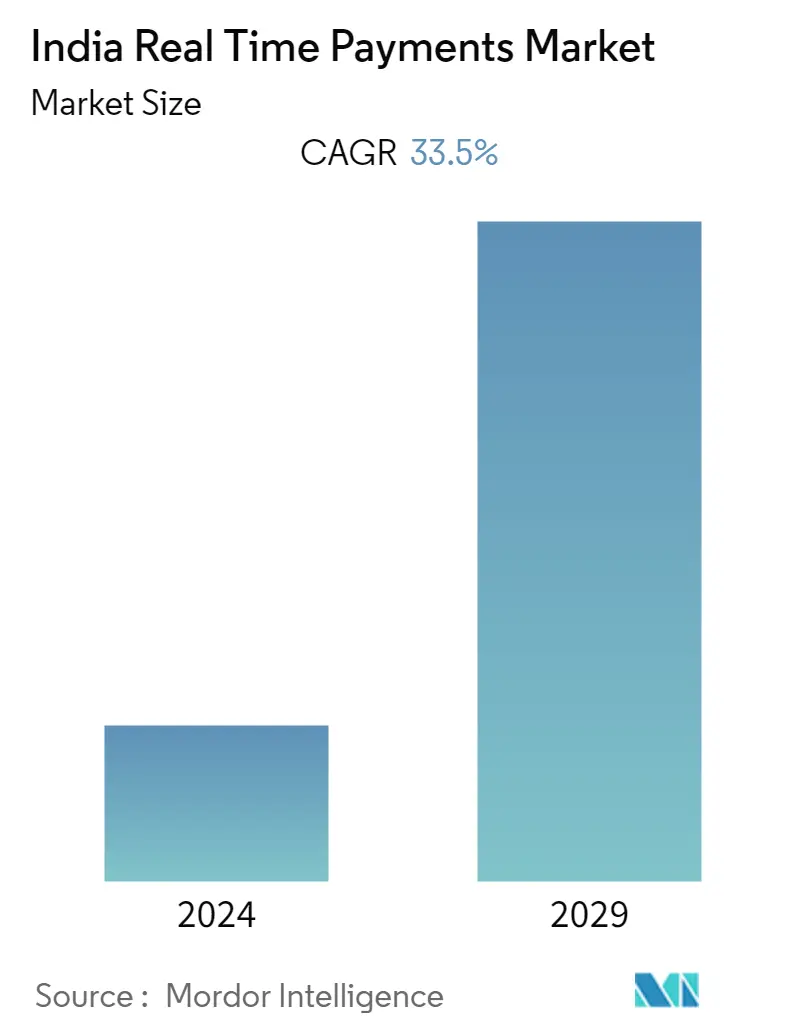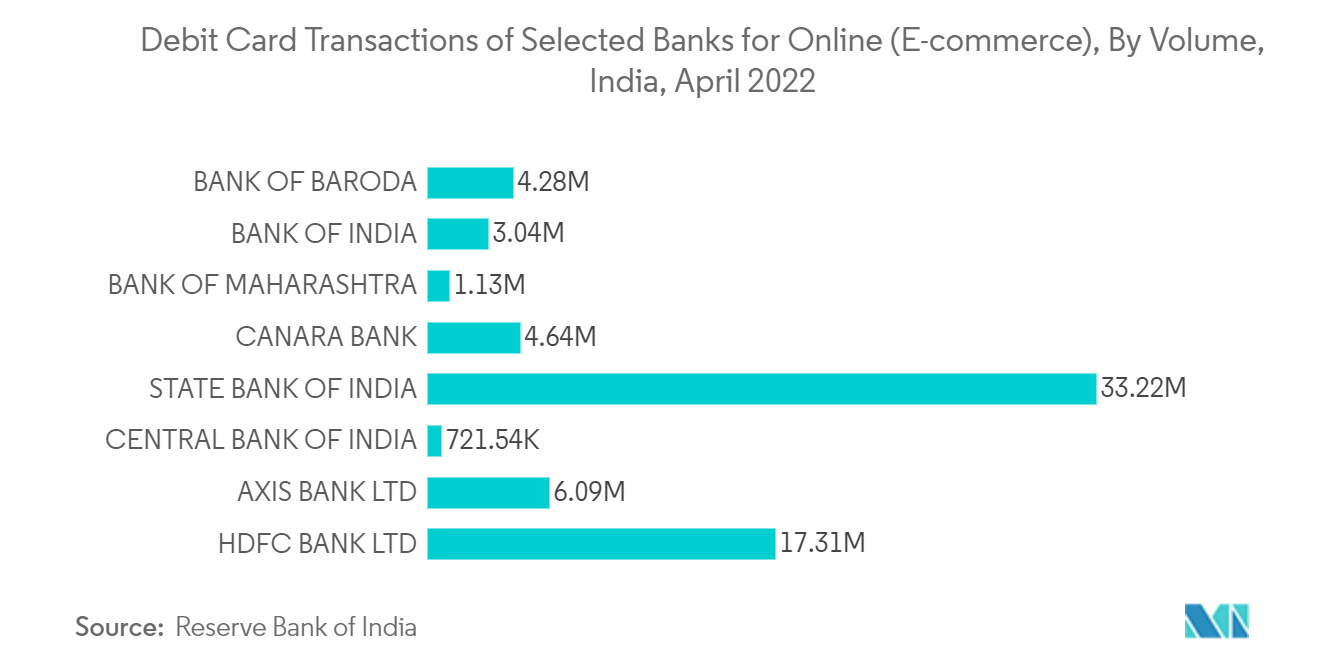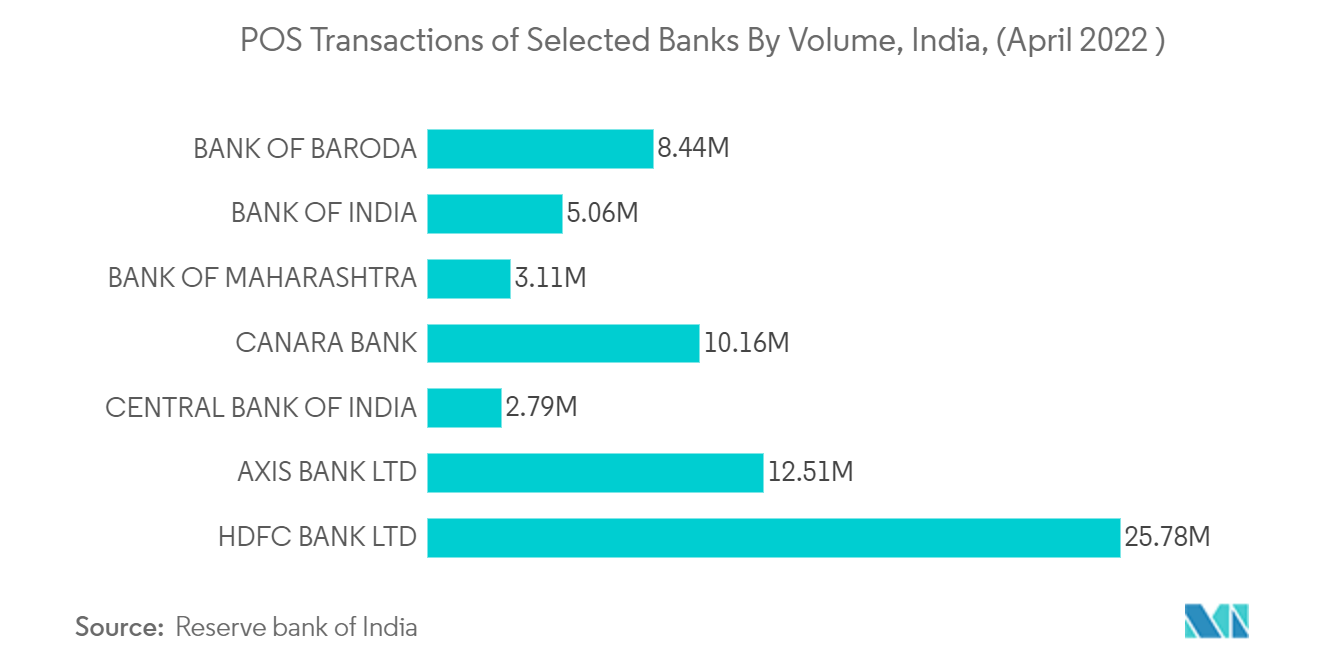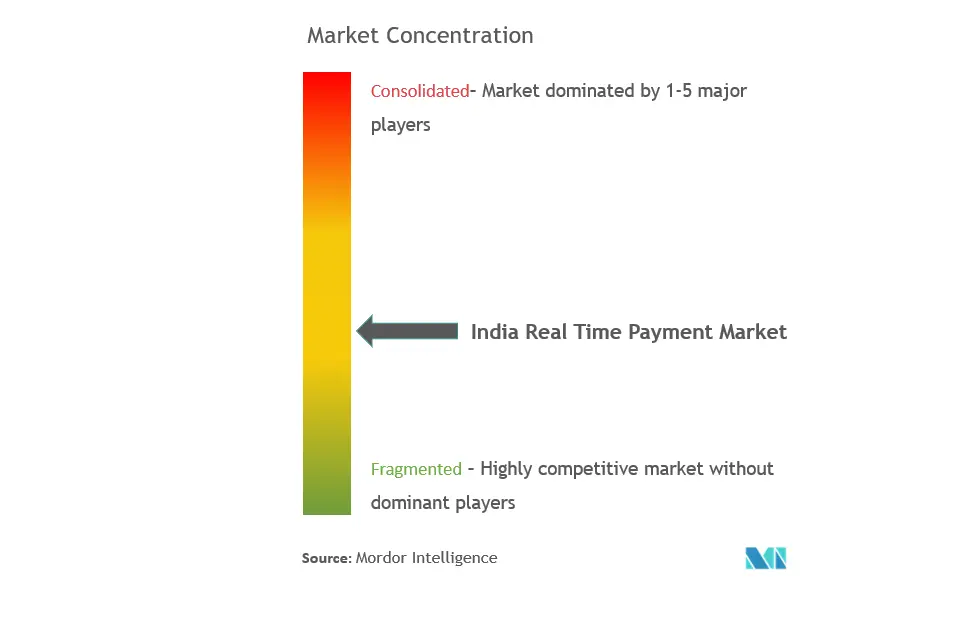India Real-Time Payments Market Size

| Study Period | 2019 - 2029 |
| Base Year For Estimation | 2023 |
| Forecast Data Period | 2024 - 2029 |
| Historical Data Period | 2019 - 2022 |
| CAGR | 33.50 % |
| Market Concentration | Medium |
Major Players
*Disclaimer: Major Players sorted in no particular order |
India Real-Time Payments Market Analysis
India's real-time payments market is expected to register a CAGR of 33.5% during the forecast period (2022 - 2027). Real-time payments typically focus on low-value retail payment systems (RPS); they differ from real-time gross settlement systems (RTGS) and distributed ledger payment systems. In addition to meeting the demands and expectations, real-time payments have generated interest from the regulators, competition authorities, and payment service providers. Regulators believe that instant payments will expand access to banking services, support economic growth, provide alternatives to Visa/Mastercard networks and reduce the use of cash and cheques.
- India has made tremendous growth when it comes to access to Internet-enabled devices in the country. For instance, the government's plan to fiberize all villages by 2025 under the BharatNet program has benefitted the banking sector in India, which has been able to make crucial changes in banking mechanisms by introducing digital means of accessing financial services through mobile phones. With instant payment systems, top banks in India have launched not just intuitive but also innovative and interactive mobile banking applications with features revolving around customer satisfaction.
- The decade of 2010-2020 can be termed as the decade of payment evolution in India. India has been transforming its payment systems over the past three decades. From barter systems to Unified Payments Interface (UPI) payment systems, India has come a long way primarily because of the failing resilience of traditional banking and the rise of Real-time Payment systems through digital transformation.
- India's central bank (RBI) plays a key role and has been supervising all these transformations. For Instance, in March 2022, RBI rolled out a digital-heavy plan for 2022-23. The central bank announced lending norms for digital platforms, rolled out a central bank digital currency, facilitated the setting up of 75 digital banks, and implemented a geo-tagging framework for POS terminals. It has proposed several measures to bring about structural reforms in the digital payments and fintech space, which has positively influenced the real time payments growth in the country.
- India has worked around its policies towards the introduction of innovative payment systems that provide instant credit to the beneficiary, with the launch of fast payment systems such as IMPS and UPI that are available to consumers round the clock for undertaking fund transfers and the introduction of mobile-based payment systems such as Bharat Bill Payment System (BBPS), PPIs to facilitate payment of bills and purchase of goods and services and National Electronic Toll Collection (NETC) to facilitate electronic toll payments.
- The convenience of these payment systems ensured rapid acceptance as they provided consumers with an alternative to using cash and paper for making payments. The facilitation of non-bank FinTech firms in the payment ecosystem as PPI issuers, BBPOUs, and third-party application providers in the UPI platform has furthered the adoption of digital payments in the country.
- The Covid-19 pandemic has had a mixed impact on the real-time payment system in India. The e-wallets saw increased traction for bill payments, P2P transfers, and P2B payments for essential services owing to the lockdown. Payment gateways saw an increase in volumes as transactions went online, tieing up with small stores selling essentials that are currently seeking to establish an online presence.
- Online frauds, including database exploits, ID thefts, phishing attacks, and card payment-related scams, are common in India, and the number has only increased during the pandemic. As per Microsoft's Global Tech Support Scam Research 2021 Report, consumers in India experienced a fairly high online fraud. 31% of Indians lost money through a scam making it the highest global encounter rate of 69% in the past year. Low internet bandwidth E-commerce entails a set of complex steps while completing a transaction, and even a minor glitch can terminate the task.
India Real-Time Payments Market Trends
This section covers the major market trends shaping the India Real Time Payments Market according to our research experts:
P2B Segment Will Hold Significant Market Share
- The real-time payment solutions for P2B transactions in India are majorly governed by the National Payments Corporation of India (NPCI). The retail payments space developed and matured with various systems operated and introduced by NPCI. To touch the lives of every Indian, NPCI has rolled out a variety of innovative retail payment products such as RuPay card scheme, IMPS, UPI, National Automated Clearing House (NACH), Aadhaar-enabled Payments System (AePS), Aadhaar Payments Bridge System (APBS), National Electronic Toll Collection(NETC), and Bharat bill pay system(BBPS). In addition, NPCI's alliance with international network partners (Japan Credit Bureau, Discover Financial Services, and China Union Pay) has paved the way for a global solution provider for the Indian real-time payment system.
- Aadhaar, a unique identification number in India issued to over 127 crore individuals Since its launch in 2009 in the country. Aadhaar-enabled e-KYC (electronic-Know Your Customer) has resulted in exponential growth of real-time payments in India. The use of Aadhaar also has leveraged authentication and processing of payments to merchants (P2B) and transactions made through Business Correspondents (BCs) (B2B) segments.
- India's UPI payment system has become the most inclusive mode of payment in India. As per the RBI data, over 26 crore unique users and five crore merchants are onboarded on the UPI platform. In May 2022, approximately 594.63 crores of transactions (INR 10.40 lakh crore) were processed through UPI, which includes (P2B) and (P2C) transactions. UPI facilitates transactions by linking Savings / Current Accounts through Debit Cards of users and is one of the key factors for developing real-time payment solutions in India.
- Further, the Reserve Bank of India operationalized the Payments Infrastructure Development Fund (PIDF) Scheme in January 2021 to incentivize the deployment of payment acceptance infrastructures such as mPoS (mobile PoS), physical Point of Sale (PoS), Quick Response (QR) codes in the North Eastern States and Tier-3 to 6 centers. The Scheme had targeted 90 lakh Points of Sale (PoS) terminals and Quick Response (QR) codes to be deployed over three years (till end-2023) in response to the rise in number of P2B transactions, aiming to ease the payment mode for merchants.
- According to the report published by ACI Worldwide, India is leading the world in real-time payment transactions in the year 2021, with 48.6 billion transactions representing more than 40% of the global commerce emerging from the country. The number of real-time transactions in India was almost 2.6 times higher than that of China and approximately seven times higher than the combined real-time payments volume of the US, France, the UK, Canada, and Germany.

Technological advancement will Further Drive the Real Time Payment Transfer
- With the rise in smartphone users and much-awaited 5G technology, India has been driving the real-time mobile payment market. For instance, The National Payments Corporation of India (NPCI) launched the UPI Lite service on-device wallet to enable people to conduct offline payments. In February 2022, UPI processed 4,527.49 million online transactions worth Rs 8,26,843. UPI Lite providing offline services will further boost the instant payment market in India.
- To upgrade the country's payment systems, RBI provided a communication backbone in the form of the satellite-based Indian Financial Network( INFINITE) using VSAT technology to the financial and banking sectors. IDRBT was entrusted with the task of designing and developing the communication network. The Closed User Group (CUG) Network uses VSAT technology. It is Time-division multiple access (TDMA)/Time-division multiplexing (TDM) network with STAR topology for Data and with Demand Assigned Multiple Access-Single Channel Per Carrier (DAMASCPC) overlaying with mesh topology for video and voice traffic.
- Indian Financial system uses contactless technology, one of the innovations in the card payments ecosystem which allows cardholders to "Tap and Go." These cards are becoming increasingly popular. To provide convenience in the use of such cards, RBI permitted relaxation in Additional Factor of Authentication (AFA) in case of Card Present (CP) transactions using Near Field Communication (NFC)-enabled EMV Chip and PIN cards for small values(INR 2,000). The limit was revised to INR 5,000, effective from January 01, 2021.
- IMPS is a 24*7 'fast payments' system introduced in 2010 and has become a widely accepted payment method between P2P modes. India was the fourth country after the UK, South Korea, and South Africa to introduce such a payment system. The system provides real-time funds transfer between the beneficiary and remitter with a deferred net settlement between banks. The system facilitates push transactions with a per-transaction limit of INR 2 lakhs.
- Unified Payments Interface (UPI) facilitates immediate money transfer through push and pull payments, utility bill payments, QR code (scan and pay) based payments, merchant payments, etc. While transacting, the UPI PIN is encrypted using Public Key Infrastructure (PKI) technology. UPI's framework comprises NPCI as network and settlement service provider, banks as Payment System Providers (PSPs), and issuer banks and beneficiary banks, apart from TPAPs such as Google Pay and WhatsApp. Non-bank PPI issuers have also provided this facility in the Indian market.

India Real-Time Payments Industry Overview
With consumer preferences changing rapidly, the market has become a lucrative option and thus, has attracted a huge amount of investments. Due to the huge growth potential, the market is moving towards fragmentation due to the new entrants. The service providers are engaging in partnerships to promote product innovation.
- June 2022 - WhatsApp has been offering Indian users USD 1.35 cashback and was allowed by the NPCI to expand its user base to 100 million, an incentive for the users to leverage WhatsApp Payments for sending money to family members, friends, and more.
- June 2022 - Unicorn Pine Labs Fintech from India Acquires API infrastructure provider Setu in a USD 70-75 Mn deal. After the deal completion, Setu will keep its brand identity, teams, business, and customers. Setu is an application programming interface (API) infrastructure provider that offers services across bill payments, savings, credit, and payments.
- March 2022 - PhonePe acquires GigIndia, to strengthen enterprise offerings. The acquisition will allow it to leverage GigIndia's network of freelance microentrepreneurs to help enterprises and corporates reach more customers and scale their distribution channels PhonePe is eyeing 2-3 more acquisitions this year to boost its tech and financial platform play. Individuals who are aware of the company's internal plans told ET on condition of anonymity.
India Real-Time Payments Market Leaders
-
Phone Pe
-
Google LLc (Alphabet Inc.)
-
NPCI
-
Paytm
-
PayPal Payments Private Limited
*Disclaimer: Major Players sorted in no particular order

India Real-Time Payments Market News
- June 2022 - The Reserve Bank of India (RBI) proposed to link credit cards with UPI (unified payment system looking forward to future growth as of 2022 in India, there was approximately 594 crore credit card transaction.
- June 2022 - RBI proposed that it's Looking to Expand UPI For Cross Border Remittance Via International Partnerships. RBI claims that the efforts with various countries are at different stages - but cross-border remittance via PayNow will begin after July 2022. So far, UPI has partnered with Singapore-based PayNow, which could be the foundation of cross border payments ecosystem in India
- April 2022 - Google Pay has launched 'Tap to pay a new feature in India, for UPI, in collaboration with Pine Labs. The feature makes use of Near Field Communication (NFC) technology. With the latest figures in the Indian market, approximately 1842 mobile devices are offering NFC technology in the Indian market(91 mobiles).
- March 2022 - Reserve Bank of India (RBI) released the framework for geo-tagging of payment system touch points to ensure proper monitoring of payment acceptance infrastructure geo-tagging refers to capturing the geographical coordinates ( longitude and latitude) of payment touchpoints deployed by the merchant to receive customer payments.
India Real-Time Payments Market Report - Table of Contents
1. INTRODUCTION
- 1.1 Study Assumptions and Market Definitions
- 1.2 Scope of the Study
2. RESEARCH METHODOLOGY
3. EXECUTIVE SUMMARY
4. MARKET INSIGHTS
- 4.1 Market Overview
-
4.2 Industry Attractiveness-Porter's Five Forces Analysis
- 4.2.1 Bargaining Power of Suppliers
- 4.2.2 Bargaining Power of Buyers/Consumers
- 4.2.3 Threat of New Entrants
- 4.2.4 Threat of Substitute Products
- 4.2.5 Intensity of Competitive Rivalry
- 4.3 Evolution of the payments landscape in the country
- 4.4 Key market trends pertaining to the growth of cashless transaction in the country
- 4.5 Impact of COVID-19 on the payments market in the country
5. MARKET DYNAMICS
-
5.1 Market Drivers
- 5.1.1 Increased Smartphone Penetration
- 5.1.2 Falling Reliance on Traditional Banking
- 5.1.3 Ease of Convenience
-
5.2 Market Challenges
- 5.2.1 Payment Fraud
- 5.2.2 Existing Dependence on Cash
-
5.3 Market Opportunities
- 5.3.1 Government Policies Encouraging the Growth of Digital Payments is expected to aid the growth of Real Time Payment methods amongst commoners
-
5.4 Key Regulations and Standards in the Digital Payments Industry
- 5.4.1 Regulatory Landscape Across the World
- 5.4.2 Business Models with Potential Regulatory Roadblocks
- 5.4.3 Scope for Development in Lieu of Evolving Business Landscape
- 5.5 Analysis of major case studies and use-cases
- 5.6 Analysis of Real Payments Transactions as a share of all Transactions with a regional breakdown of key countries by volume and transacted value
- 5.7 Analysis of Real Payments Transactions as a share of Non-Cash Transactions with a regional breakdown of key countries by volumes
6. MARKET SEGMENTATION
-
6.1 By Type of Payment
- 6.1.1 P2P
- 6.1.2 P2B
7. COMPETITIVE LANDSCAPE
-
7.1 Company Profiles
- 7.1.1 Temenos AG
- 7.1.2 ACI Worldwide
- 7.1.3 Google LLC (Alphabet Inc.)
- 7.1.4 Paypal Holdings Inc.
- 7.1.5 Mastercard Inc.
- 7.1.6 Paytm
- 7.1.7 NPCI
- 7.1.8 VISA Inc.
- 7.1.9 Razorpay Technologies Private Limited
- 7.1.10 Volante Technologies Inc.
- 7.1.11 PhonePe Private Limited
- *List Not Exhaustive
8. INVESTMENT ANALYSIS
9. FUTURE OUTLOOK OF THE MARKET
** Subject To AvailablityIndia Real-Time Payments Industry Segmentation
The Indian Real-Time Payments Market is Segmented by Mode of Payment (Person-to-Person (P2P) and Person-to-Business (P2B)). Real-time payment is a fully electronic payment system in which irrevocable funds are transferred from the remitter and credited to the beneficiary, where confirmation back to the originator and receiver of the payment is available in one minute or less.
Banks interested in connecting to the RTP network typically work with a technology provider with a streamlined process that enables them to do so. For example, providers such as PayPal India, PayUmoney, Paytm, CCAvenue, Razorpay, Instamojo, Cashfree, HDFC PayZapp, BHIM Axis Pay, SBI Pay, and many more are currently providing real-time payment transfer services in the country.
| By Type of Payment | P2P |
| P2B |
India Real-Time Payments Market Research FAQs
What is the current India Real Time Payments Market size?
The India Real Time Payments Market is projected to register a CAGR of 33.5% during the forecast period (2024-2029)
Who are the key players in India Real Time Payments Market?
Phone Pe, Google LLc (Alphabet Inc.), NPCI, Paytm and PayPal Payments Private Limited are the major companies operating in the India Real Time Payments Market.
What years does this India Real Time Payments Market cover?
The report covers the India Real Time Payments Market historical market size for years: 2019, 2020, 2021, 2022 and 2023. The report also forecasts the India Real Time Payments Market size for years: 2024, 2025, 2026, 2027, 2028 and 2029.
Real-Time Payments in India Industry Report
Statistics for the 2024 Real-Time Payments in India market share, size and revenue growth rate, created by Mordor Intelligence™ Industry Reports. Real-Time Payments in India analysis includes a market forecast outlook 2029 and historical overview. Get a sample of this industry analysis as a free report PDF download.



